Rural Public Acceptance of Wind and Solar Energy: A Case Study from Mersing, Malaysia
Abstract
1. Introduction
1.1. The Features of Energy Production Structure in Malaysia
1.2. The Possibilities, Challenges and Actions in the Scope of Promotion and Proliferation of RES
2. Theoretical Background
3. Area of Study
4. Methodology
4.1. Survey on EKOMAR Prior to the RE Project
4.2. The Survey after the RE Project at EKOMAR
5. Results and Discussion
5.1. Respondent Demographics
5.2. Data Analysis for the First Survey
5.3. Data Analysis for the Second Survey
6. Conclusions and Policy Implications
- (a)
- The promotion of RE technologies is a crucial step before the implementation of these technologies and should be done properly, particularly in remote regions, to enhance the awareness and knowledge of RE technologies among the rural public. This is because the rural residents usually have a relatively low awareness and knowledge of RE technologies, due to a relatively low educational background. The knowledge of RE technology will therefore be increased as they recognize the technology, know its true benefits and comprehend the objective and environmental value of the technology, besides appreciating its functions. In the sense of learning activities at all stages, educational programs on ER should be introduced and organized as education is one of the most effective forms of getting input into RE technology. Nevertheless, focus should be put on the learning, descriptive, investigative and creative execution of RE education [86]. RE education indeed plays a key role in the growth of a sustainable society. Consciousness of and concern within communities for RE technology should be provided to increase public awareness of various forms of RE energy as alternatives to the current energy to deepen the public trust in the implementation of RE technologies, as well as to build practical principles and social attitudes towards using RE sources [86,87,88,89]. As in Malaysia at the moment, RE education is a relatively new field and this program has been offered in formal education at university level, such as in Universiti Malaya (master of renewable energy). However, it is pertinent to include RE education programs in any level of education to ensure public understanding towards RE technologies and that sources can be improved for sustainable development in Malaysia.
- (b)
- The implementation of RE technologies is the sustainable solution to address energy poverty and lack-of-electricity issues in rural areas. This is supported by Fadaeneejad et al. [60], mentioning that, in recent years, rural electrification using hybrid renewable energy systems is a reliable solution for villages that have no electricity. The proportion of rural electrification in the Peninsular Malaysia is high in over 90% with assessable grid connections. In 2001, a Feed-in-Tariff (FiT) Act was adopted by the Malaysia government and employed in FiT RE payment as an established incentive structure for the implementation of RE under the state law. Domestic electricity utilities are required to buy renewable electricity at surplus government market prices. The increased costs tend to reduce RE suppliers’ expense drawbacks. Specific forms of RE electricity generation may have different rates.
Author Contributions
Funding
Acknowledgments
Conflicts of Interest
References
- Malaysia Energy Commission. National Energy Balance 2014. 2016. Available online: http://meih.st.gov.my/documents/10620/5bb0f85c-fc99-4743-a8a9-8ee0d65f1299 (accessed on 30 November 2019).
- Ang, J.B. Economic development, pollutant emissions and energy consumption in Malaysia. J. Policy Model. 2008, 30, 271–278. [Google Scholar] [CrossRef]
- Malaysia Energy Information Hub. Statistics. Available online: http://meih.st.gov.my/statistics (accessed on 3 December 2019).
- Azlina, A.A. Energy consumption and economic development in Malaysia: A multivariate cointegration analysis. Procedia Soc. Behav. Sci. 2012, 65, 674–681. [Google Scholar] [CrossRef][Green Version]
- Mekhilef, S.; Barimani, M.; Safari, A.; Salam, Z. Malaysia’s renewable energy policies and programs with green aspects. Renew. Sustain. Energy Rev. 2014, 40, 497–504. [Google Scholar] [CrossRef]
- Bujang, A.S.; Bern, C.J.; Brumm, T.J. Summary of energy demand and renewable energy policies in Malaysia. Renew. Sustain. Energy Rev. 2016, 53, 1459–1467. [Google Scholar] [CrossRef]
- Petinrin, J.O.; Shaaban, M. Renewable energy for continuous energy sustainability in Malaysia. Renew. Sustain. Energy Rev. 2015, 50, 967–981. [Google Scholar] [CrossRef]
- Maggio, G.; Cacciola, G. When will oil, natural gas, and coal peak? Fuel 2012, 98, 111–123. [Google Scholar] [CrossRef]
- Chua, S.C.; Oh, T.H. Review on Malaysia’s national energy developments: Key policies, agencies, programmes and international involvements. Renew. Sustain. Energy Rev. 2010, 14, 2916–2925. [Google Scholar] [CrossRef]
- Oh, T.H.; Pang, S.Y.; Chua, S.C. Energy policy and alternative energy in Malaysia: Issues and challenges for sustainable growth. Renew. Sustain. Energy Rev. 2010, 14, 1241–1252. [Google Scholar] [CrossRef]
- Panwar, N.L.; Kaushik, S.C.; Kothari, S. Role of renewable energy sources in environmental protection: A review. Renew. Sustain. Energy Rev. 2011, 15, 1513–1524. [Google Scholar] [CrossRef]
- Höök, M.; Tang, X. Depletion of fossil fuels and anthropogenic climate change—A review. Energy Policy 2013, 52, 797–809. [Google Scholar] [CrossRef]
- Safaai, N.S.; Noor, Z.Z.; Hashim, H.; Ujang, Z.; Talib, J. Projection of CO2 emissions in Malaysia. Environ. Prog. Sustain. Energy 2011, 30, 658–665. [Google Scholar] [CrossRef]
- Davis, S.J.; Caldeira, K.; Matthews, H.D. Future CO2 emissions and climate change from existing energy infrastructure. Science 2010, 329, 1330–1333. [Google Scholar] [CrossRef] [PubMed]
- Shaffer, G.; Olsen, S.M.; Pedersen, J.O. Long-term ocean oxygen depletion in response to carbon dioxide emissions from fossil fuels. Nat. Geosci. 2009, 2, 105–109. [Google Scholar] [CrossRef]
- CDIAC; UNFCCC; BP. Global and Malaysian Carbon Dioxide Emission. Available online: http://emissions2015.globalcarbonatlas.org/# (accessed on 3 December 2019).
- Moula, M.M.; Maula, J.; Hamdy, M.; Fang, T.; Jung, N.; Lahdelma, R. Researching social acceptability of renewable energy technologies in Finland. Int. J. Sustain. Built Environ. 2013, 2, 89–98. [Google Scholar] [CrossRef]
- Mohamed, A.R.; Lee, K.T. Energy for sustainable development in Malaysia: Energy policy and alternative energy. Energy Policy 2006, 34, 2388–2397. [Google Scholar] [CrossRef]
- Hashim, H.; Ho, W.S. Renewable energy policies and initiatives for a sustainable energy future in Malaysia. Renew. Sustain. Energy Rev. 2011, 15, 4780–4787. [Google Scholar] [CrossRef]
- Ministry of Energy, Water and Communication (KeTTHA). National Renewable Energy Policy and Action Plan; Ministry of Energy, Water and Communication: Kuala Lumpur, Malaysia, 2016. Available online: http://www.seda.gov.my/ (accessed on 13 November 2019).
- Oh, T.H.; Hasanuzzaman, M.; Selvaraj, J.; Teo, S.C.; Chua, S.C. Energy policy and alternative energy in Malaysia: Issues and challenges for sustainable growth–An update. Renew. Sustain. Energy Rev. 2017, 81, 3021–3031. [Google Scholar] [CrossRef]
- Sustainable Energy Development Authority Malaysia (SEDA). Renewable Energy Installed Capacities. Available online: http://www.seda.gov.my/statistics-monitoring/re-installed-capacities/ (accessed on 13 November 2019).
- Sustainable Energy Development Authority Malaysia (SEDA). Renewable Energy Generation. Available online: http://www.seda.gov.my/statistics-monitoring/re-generation/ (accessed on 13 November 2019).
- New Starts Times (NST). Construction of TNB’s Large Scale Solar Project to Start Next Month. 2017. Available online: https://www.nst.com.my/business/2017/06/245654/construction-tnbs-large-scale-solar-project-start-next-month (accessed on 13 November 2019).
- New Starts Times (NST). TNB’s Mukim Tanjung 12 LSS Contributes 73.2 MW of RE to National Grid. 2018. Available online: https://www.nst.com.my/business/2018/12/437586/tnbs-mukim-tanjung-12-lss-contributes-732-mw-re-national-grid (accessed on 10 March 2020).
- Marine Ecosystem Research Centre (EKOMAR). Available online: http://www.ukm.my/ekomar/about-us/ (accessed on 12 December 2019).
- Amin, N.; Lung, C.W.; Sopian, K. A practical field study of various solar cells on their performance in Malaysia. Renew. Energy 2009, 34, 1939–1946. [Google Scholar] [CrossRef]
- Chua, S.C.; Oh, T.H. Solar energy outlook in Malaysia. Renew. Sustain. Energy Rev. 2012, 16, 564–574. [Google Scholar] [CrossRef]
- Mekhilef, S.; Safari, A.; Mustaffa, W.E.; Saidur, R.; Omar, R.; Younis, M.A. Solar energy in Malaysia: Current state and prospects. Renew. Sustain. Energy Rev. 2012, 16, 386–396. [Google Scholar] [CrossRef]
- Ahmad, S.; Ab Kadir, M.Z.; Shafie, S. Current perspective of the renewable energy development in Malaysia. Renew. Sustain. Energy Rev. 2011, 15, 897–904. [Google Scholar] [CrossRef]
- Haris, A.H. MBIPV Project: Catalyzing local PV Market. Finance and Investment Forum on PV Technology. 2008. Available online: http://www.mbipv.net.my/dload/fif-hh.pdf (accessed on 5 December 2019).
- Masseran, N.; Razali, A.M.; Ibrahim, K. An analysis of wind power density derived from several wind speed density functions: The regional assessment on wind power in Malaysia. Renew. Sustain. Energy Rev. 2012, 16, 6476–6487. [Google Scholar] [CrossRef]
- Masseran, N.; Razali, A.M.; Ibrahim, K.; Zin, W.W.; Zaharim, A. On spatial analysis of wind energy potential in Malaysia. WSEAS Trans. Math. 2012, 11, 467–477. [Google Scholar]
- Sopian, K.; Othman, M.H.; Wirsat, A. The wind energy potential of Malaysia. Renew. Energy 1995, 6, 1005–1016. [Google Scholar] [CrossRef]
- Borhanazad, H.; Mekhilef, S.; Saidur, R.; Boroumandjazi, G. Potential application of renewable energy for rural electrification in Malaysia. Renew. Energy 2013, 59, 210–219. [Google Scholar] [CrossRef]
- Del Río, P.; Burguillo, M. Assessing the impact of renewable energy deployment on local sustainability: Towards a theoretical framework. Renew. Sustain. Energy Rev. 2008, 12, 1325–1344. [Google Scholar] [CrossRef]
- Del Rio, P.; Burguillo, M. An empirical analysis of the impact of renewable energy deployment on local sustainability. Renew. Sustain. Energy Rev. 2009, 13, 1314–1325. [Google Scholar] [CrossRef]
- Walker, G. Renewable energy and the public. Land Use Policy 1995, 12, 49–59. [Google Scholar] [CrossRef]
- Wüstenhagen, R.; Wolsink, M.; Bürer, M.J. Social acceptance of renewable energy innovation: An introduction to the concept. Energy Policy 2007, 35, 2683–2691. [Google Scholar] [CrossRef]
- Sütterlin, B.; Siegrist, M. Public acceptance of renewable energy technologies from an abstract versus concrete perspective and the positive imagery of solar power. Energy Policy 2017, 106, 356–366. [Google Scholar] [CrossRef]
- Aklin, M.; Cheng, C.Y.; Urpelainen, J. Social acceptance of new energy technology in developing countries: A framing experiment in rural India. Energy Policy 2018, 113, 466–477. [Google Scholar] [CrossRef]
- Devine-Wright, P. Reconsidering public attitudes and public acceptance of renewable energy technologies: A critical review. In Beyond Nimbyism: A Multidisciplinary Investigation of Public Engagement with Renewable Energy Technologies; Manchester, UK, 2007; Available online: http://geography.exeter.ac.uk/beyond_nimbyism/deliverables/bn_wp1_4.pdf (accessed on 13 November 2019).
- Devine-Wright, P. Place attachment and public acceptance of renewable energy: A tidal energy case study. J. Environ. Psychol. 2011, 31, 336–343. [Google Scholar] [CrossRef]
- Tanujaya, R.R.; Lee, C.Y.; Woo, J.; Huh, S.Y.; Lee, M.K. Quantifying public preferences for community-based renewable energy projects in South Korea. Energies 2020, 13, 2384. [Google Scholar] [CrossRef]
- Wolsink, M. Undesired reinforcement of harmful ‘self-evident truths’ concerning the implementation of wind power. Energy Policy 2012, 48, 83–87. [Google Scholar] [CrossRef]
- Seidl, R.; Von Wirth, T.; Krütli, P. Social acceptance of distributed energy systems in Swiss, German, and Austrian energy transitions. Energy Res. Soc. Sci. 2019, 54, 117–128. [Google Scholar] [CrossRef]
- Zoellner, J.; Schweizer-Ries, P.; Wemheuer, C. Public acceptance of renewable energies: Results from case studies in Germany. Energy Policy 2008, 36, 4136–4141. [Google Scholar] [CrossRef]
- Jobert, A.; Laborgne, P.; Mimler, S. Local acceptance of wind energy: Factors of success identified in French and German case studies. Energy Policy 2007, 35, 2751–2760. [Google Scholar] [CrossRef]
- Soland, M.; Steimer, N.; Walter, G. Local acceptance of existing biogas plants in Switzerland. Energy Policy 2013, 61, 802–810. [Google Scholar] [CrossRef]
- Kortsch, T.; Hildebrand, J.; Schweizer-Ries, P. Acceptance of biomass plants–Results of a longitudinal study in the bioenergy-region Altmark. Renew. Energy 2015, 83, 690–697. [Google Scholar] [CrossRef]
- Schumacher, K.; Schultmann, F. Local acceptance of biogas plants: A comparative study in the Trinational Upper Rhine Region. Waste Biomass Valorization 2017, 8, 2393–2412. [Google Scholar] [CrossRef]
- Scherhaufer, P.; Höltinger, S.; Salak, B.; Schauppenlehner, T.; Schmidt, J. A participatory integrated assessment of the social acceptance of wind energy. Energy Res. Soc. Sci. 2018, 45, 164–172. [Google Scholar] [CrossRef]
- Liu, W.; Wang, C.; Mol, A.P. Rural public acceptance of renewable energy deployment: The case of Shandong in China. Appl. Energy 2013, 102, 1187–1196. [Google Scholar] [CrossRef]
- Hanley, N.; Nevin, C. Appraising renewable energy developments in remote communities: The case of the North Assynt Estate, Scotland. Energy Policy 1999, 27, 527–547. [Google Scholar] [CrossRef]
- Borchers, A.M.; Duke, J.M.; Parsons, G.R. Does willingness to pay for green energy differ by source? Energy Policy 2007, 35, 3327–3334. [Google Scholar] [CrossRef]
- Hosseini, A.; Zolfagharzadeh, M.M.; Asghar Sadabadi, A.; Aslani, A.; Jafari, H. Social acceptance of renewable energy in developing countries: Challenges and opportunities. Distrib. Gener. Altern. Energy J. 2018, 33, 31–48. [Google Scholar] [CrossRef]
- Lim, X.L.; Lam, W.H. Public acceptance of marine renewable energy in Malaysia. Energy Policy 2014, 65, 16–26. [Google Scholar] [CrossRef]
- Kardooni, R.; Yusoff, S.B.; Karim, F.B. Renewable energy technology acceptance in Peninsular Malaysia. Energy Policy 2016, 88, 1–10. [Google Scholar] [CrossRef]
- Kardooni, R.; Yusoff, S.B.; Kari, F.B.; Moeenizadeh, L. Public opinion on renewable energy technologies and climate change in peninsular Malaysia. Renew. Energy 2018, 116, 659–668. [Google Scholar] [CrossRef]
- Fadaeenejad, M.; Radzi, M.A.; AbKadir, M.Z.; Hizam, H. Assessment of hybrid renewable power sources for rural electrification in Malaysia. Renew. Sustain. Energy Rev. 2014, 30, 299–305. [Google Scholar] [CrossRef]
- Halili, S.H.; Sulaiman, H. Factors influencing the rural students’ acceptance of using ICT for educational purposes. Kasetsart J. Soc. Sci. 2018. [Google Scholar] [CrossRef]
- Google 2019. Available online: https://maps.googleapis.com/maps/api/staticmap?center=2.58,103.806&zoom=13&size=640x640&scale=2&maptype=terrain&language=en-EN&key=xxx (accessed on 15 December 2019).
- Babakus, E.; Mangold, W.G. Adapting the SERVQUAL scale to hospital services: An empirical investigation. Health Serv. Res. 1992, 26, 767–786. [Google Scholar] [PubMed]
- Cortese, A.D. The critical role of higher education in creating a sustainable future. Plan. High. Educ. 2003, 31, 15–22. [Google Scholar]
- Stephens, J.C.; Hernandez, M.E.; Román, M.; Graham, A.C.; Scholz, R.W. Higher education as a change agent for sustainability in different cultures and contexts. Int. J. Sustain. High. Educ. 2008, 9, 317–338. [Google Scholar] [CrossRef]
- Department of Statistics Malaysia (DOSM). Press Release Report of Household Income and Basic Amenities Survey 2014. 2015. Available online: https://www.dosm.gov.my/v1/index.php?r=column/pdfPrev&id=aHhtTHVWNVYzTFBua2dSUlBRL1Rjdz09 (accessed on 30 December 2019).
- Weigt, H. Germany’s wind energy: The potential for fossil capacity replacement and cost saving. Appl. Energy 2009, 86, 1857–1863. [Google Scholar] [CrossRef]
- Eltham, D.C.; Harrisonm, G.P.; Allen, S.J. Change in public attitudes towards a Cornish wind farm: Implications for planning. Energy Policy 2008, 36, 23–33. [Google Scholar] [CrossRef]
- Frantál, B.; Kunc, J. Wind turbines in tourism landscapes: Czech experience. Ann. Tour. Res. 2011, 38, 499–519. [Google Scholar] [CrossRef]
- Frantál, B.; Urbánková, R. Energy tourism: An emerging field of study. Curr. Issues Tour. 2017, 20, 1395–1412. [Google Scholar] [CrossRef]
- de Sousa, A.J.; Kastenholz, E. Wind farms and the rural tourism experience–problem or possible productive integration? The views of visitors and residents of a Portuguese village. J. Sustain. Tour. 2015, 23, 1236–1256. [Google Scholar] [CrossRef]
- Beer, M.; Rybár, R.; Ka’avský, M. Renewable energy sources as an attractive element of industrial tourism. Curr. Issues Tour. 2018, 21, 2139–2151. [Google Scholar] [CrossRef]
- Molnarova, K.; Sklenicka, P.; Stiborek, J.; Svobodova, K.; Salek, M.; Brabec, E. Visual preferences for wind turbines: Location, numbers and respondent characteristics. Appl. Energy 2012, 92, 269–278. [Google Scholar] [CrossRef]
- Strazzera, E.; Mura, M.; Contu, D. Combining choice experiments with psychometric scales to assess the social acceptability of wind energy projects: A latent class approach. Energy Policy 2012, 48, 334–347. [Google Scholar] [CrossRef]
- Broekel, T.; Alfken, C. Gone with the wind? The impact of wind turbines on tourism demand. Energy Policy 2015, 86, 506–519. [Google Scholar] [CrossRef]
- Teisl, M.F.; Noblet, C.L.; Corey, R.R.; Giudice, N.A. Seeing clearly in a virtual reality: Tourist reactions to an offshore wind project. Energy Policy 2018, 122, 601–611. [Google Scholar] [CrossRef]
- Michalena, E.; Hills, J.; Amat, J.P. Developing sustainable tourism, using a multicriteria analysis on renewable energy in Mediterranean Islands. Energy Sustain. Dev. 2009, 13, 129–136. [Google Scholar] [CrossRef]
- Michalena, E.; Tripanagnostopoulos, Y. Contribution of the solar energy in the sustainable tourism development of the Mediterranean islands. Renew. Energy 2010, 35, 667–673. [Google Scholar] [CrossRef]
- Brau, R. Demand-driven sustainable tourism? A choice modelling analysis. Tour. Econ. 2008, 14, 691–708. [Google Scholar] [CrossRef]
- Sadat, M.M.; Chang, L.H. The impact of environmental quality of revisiting intention. J. Qual. Assur. Hosp. Tour. 2016, 17, 209–223. [Google Scholar] [CrossRef]
- Zakhidov, R.A. Central Asian countries energy system and role of renewable energy sources. Appl. Sol. Energy 2008, 44, 218–223. [Google Scholar] [CrossRef]
- Chong, H.Y.; Lam, W.H. Ocean renewable energy in Malaysia: The potential of the Straits of Malacca. Renew. Sustain. Energy Rev. 2013, 23, 169–178. [Google Scholar] [CrossRef]
- Omer, A.M. Energy, environment and sustainable development. Renew. Sustain. Energy Rev. 2008, 12, 2265–2300. [Google Scholar] [CrossRef]
- Chen, W.N. Renewable Energy Status in Malaysia. SEDA. 2012. Available online: http://www.mida.gov.my/env3/uploads/events/Sabah04122012/SEDA.pdf (accessed on 30 December 2019).
- Malek, B.A. Renewable energy development in Malaysia. In Proceedings of the APEC Expert Group on New and Renewable Energy Technologies (EGNRET) 34th Meeting, Kuala Lumpur, Malaysia, 26–28 April 2010. [Google Scholar]
- Kandpal, T.C.; Broman, L. Renewable energy education: A global status review. Renew. Sustain. Energy Rev. 2014, 34, 300–324. [Google Scholar] [CrossRef]
- Acikgoz, C. Renewable energy education in Turkey. Renew. Energy 2011, 36, 608–611. [Google Scholar] [CrossRef]
- Jennings, P. New directions in renewable energy education. Renew. Energy 2009, 34, 435–439. [Google Scholar] [CrossRef]
- Jennings, P.; Lund, C. Renewable energy education for sustainable development. Renew. Energy 2001, 22, 113–118. [Google Scholar] [CrossRef]
- Sustainable Energy Development Authority Malaysia (SEDA). Installed Capacity (MW) of Commissioned RE Installations (FiT Program). Available online: http://www.seda.gov.my/feed-in-tarif-fit/renewable-resources/ (accessed on 5 January 2020).
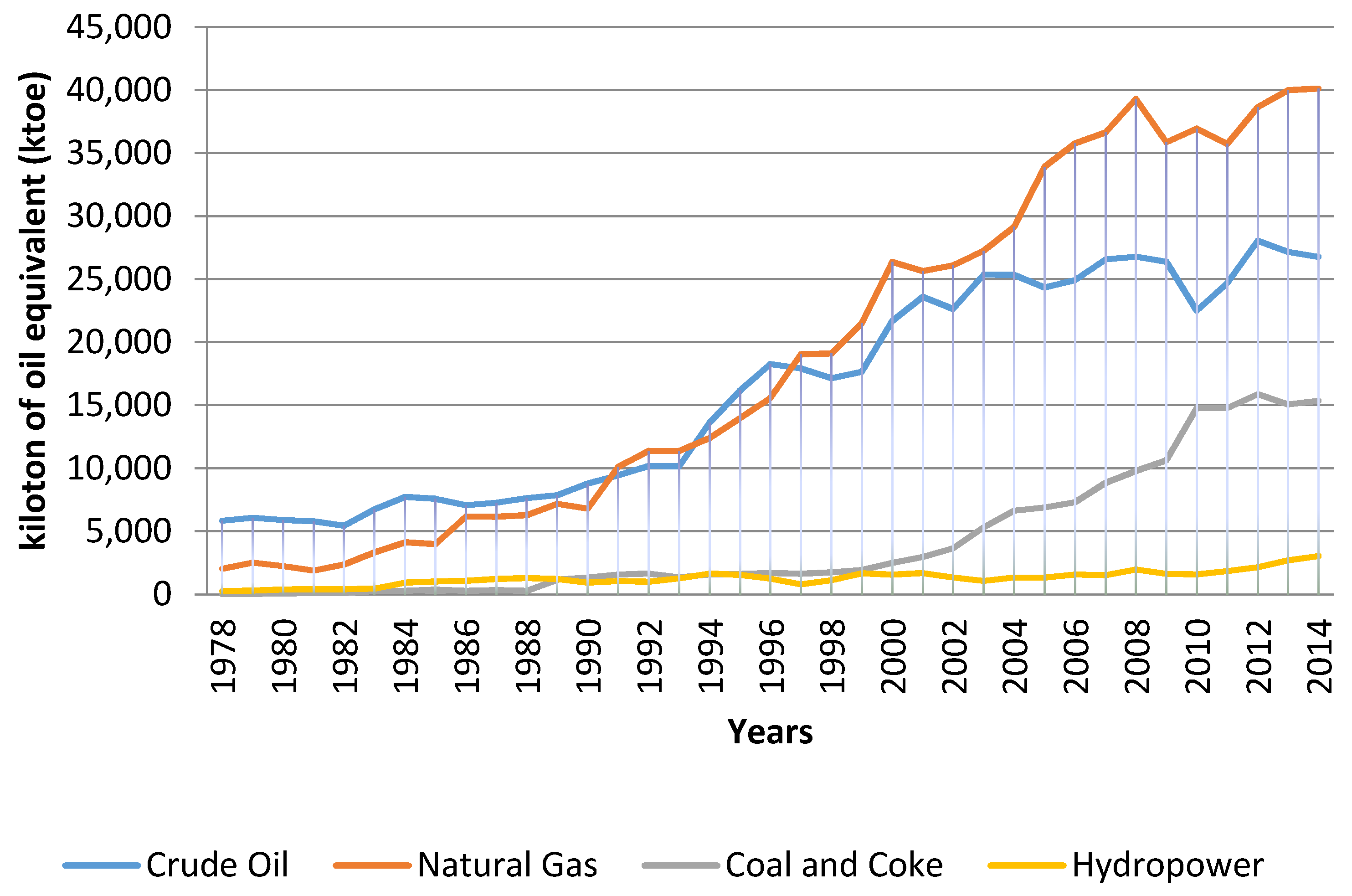
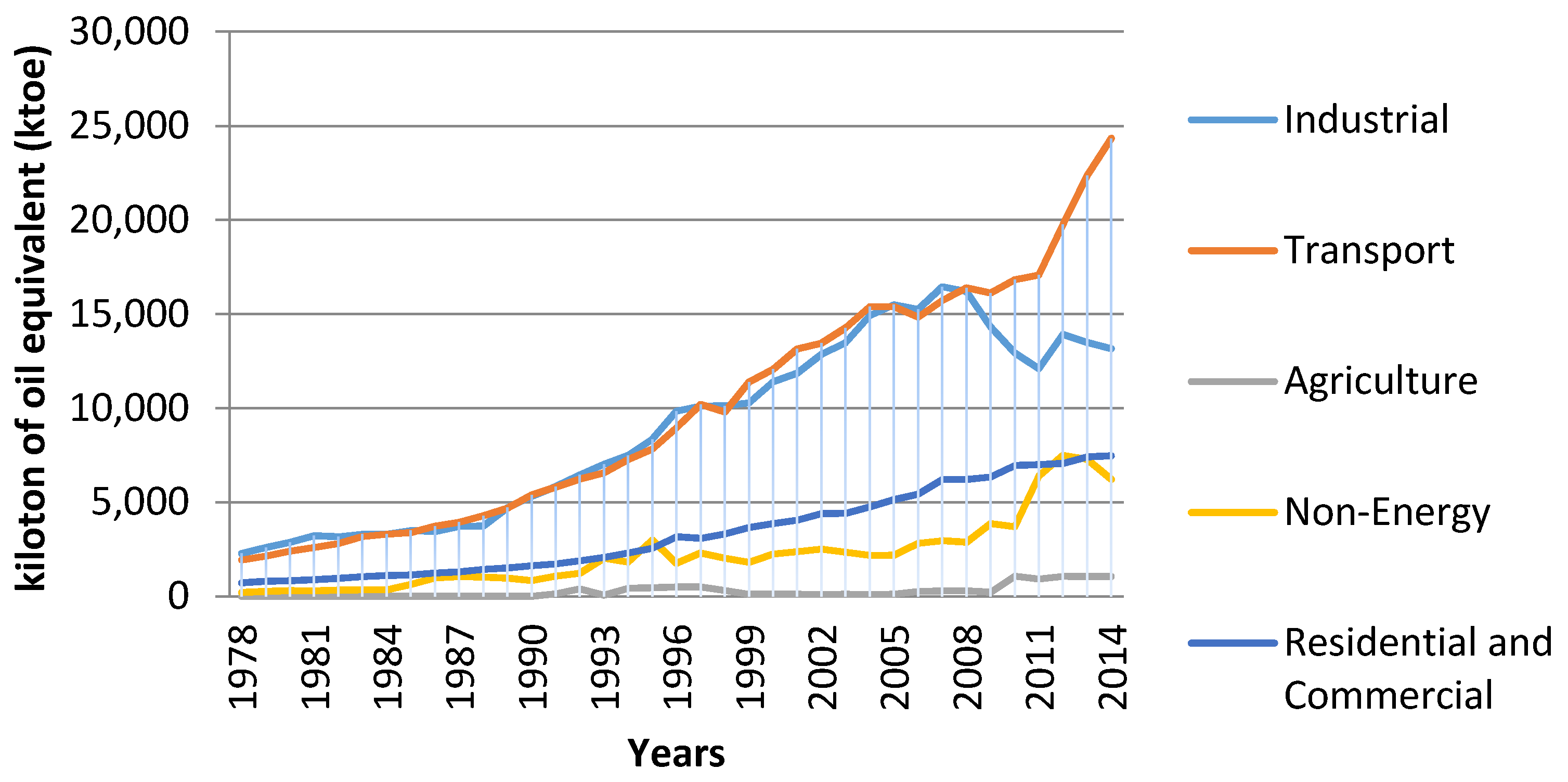




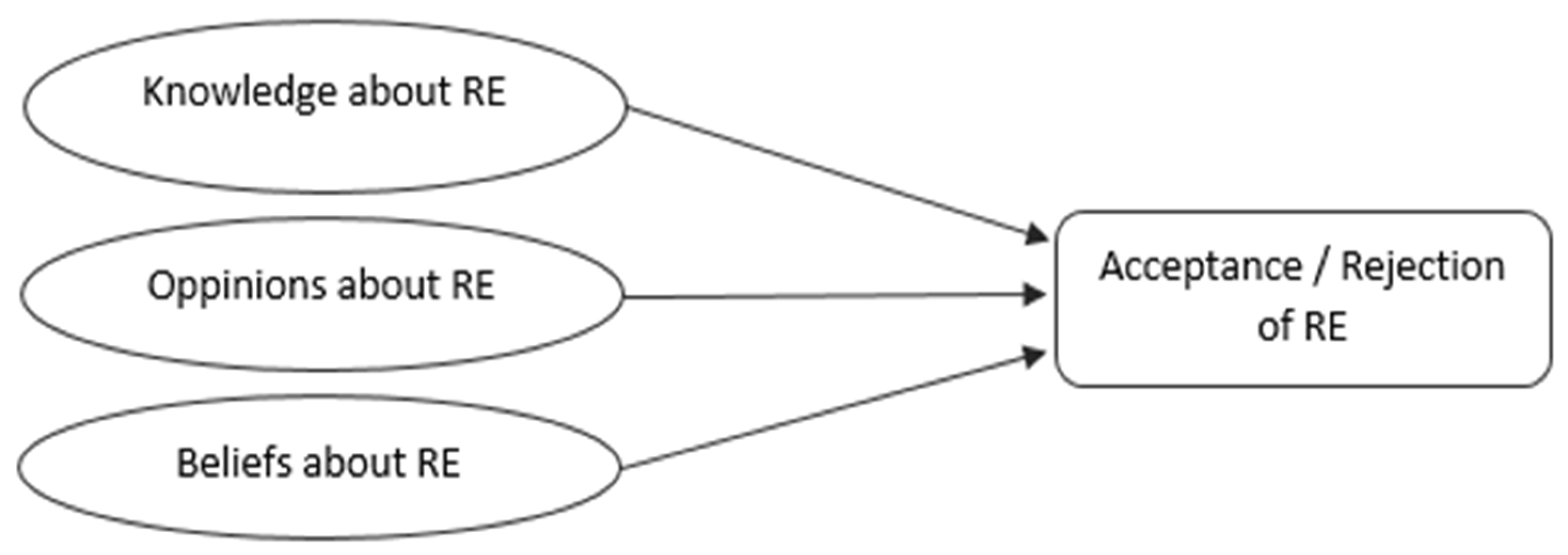



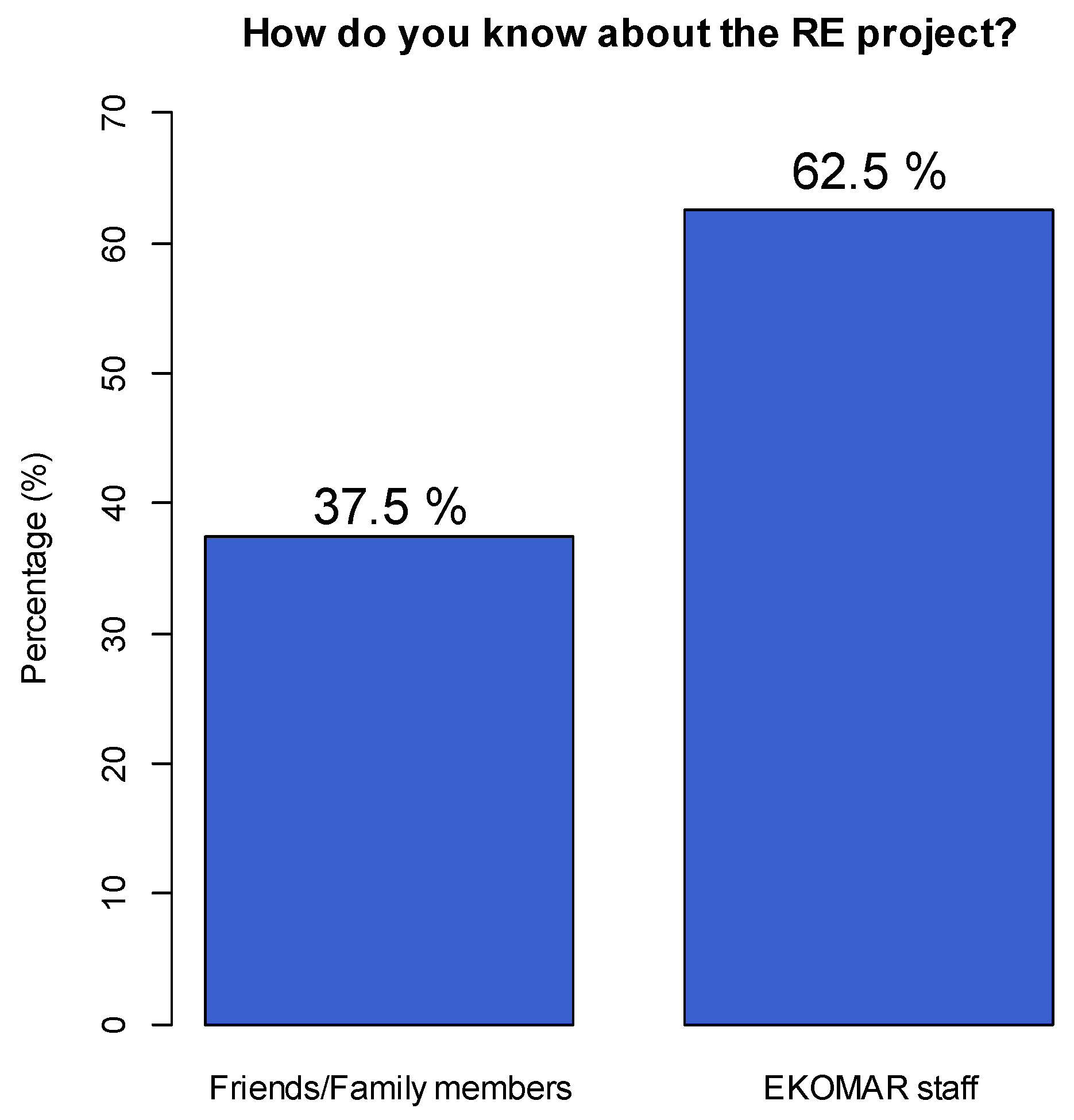



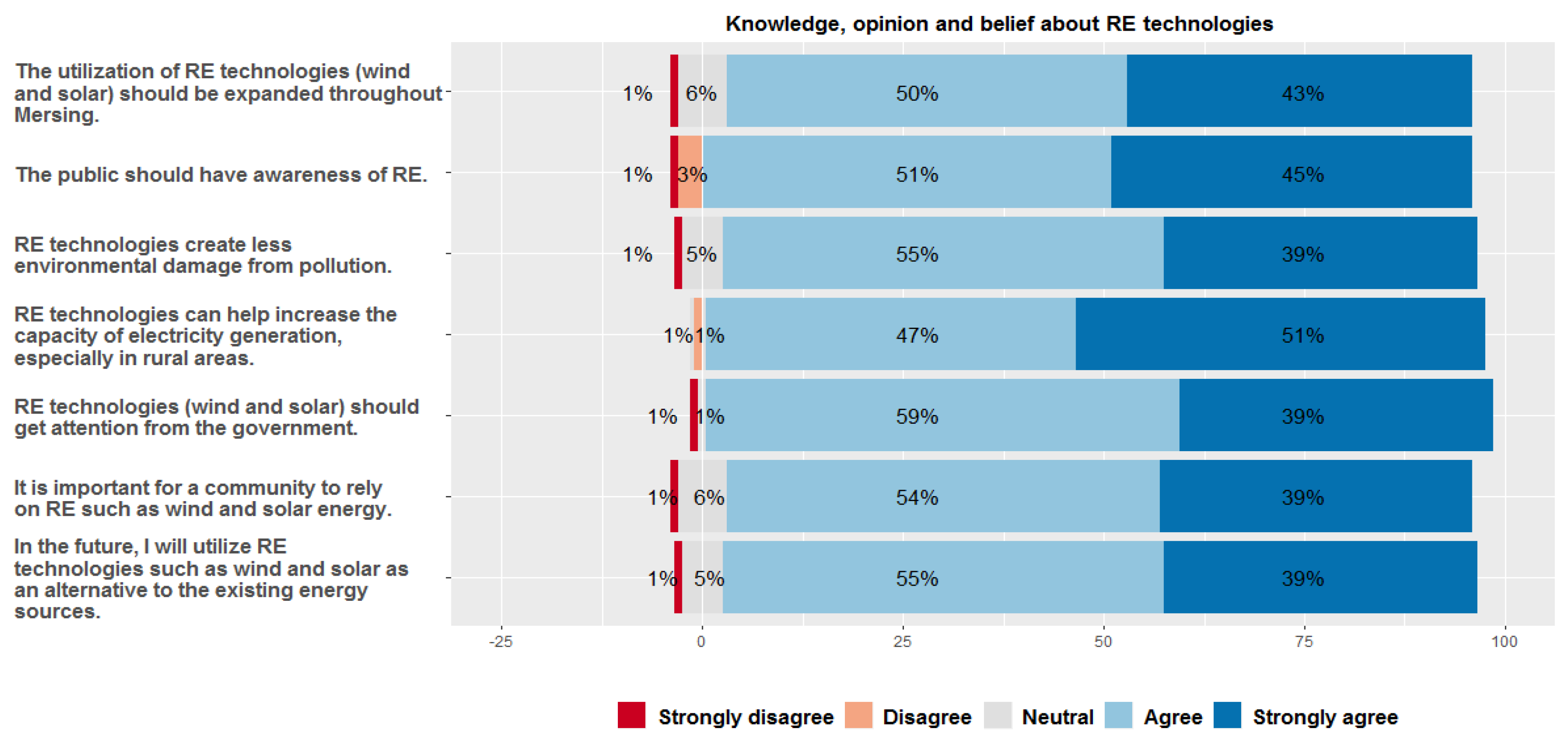


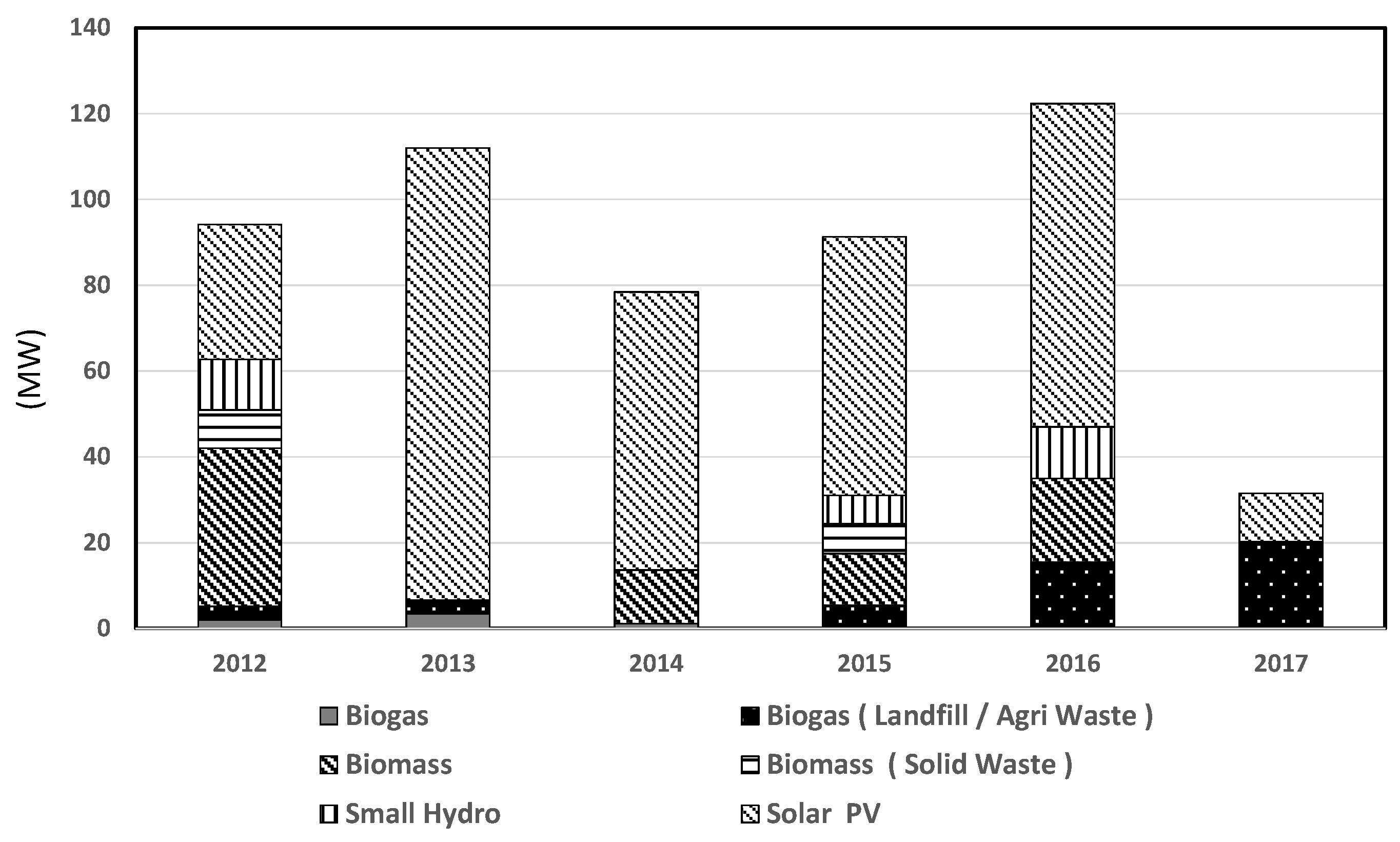
| Year | Biogas | Biogas (Landfill/Agri-Waste | Biomass | Biomass (Solid Waste) | Small Hydro | Solar PV | Total |
|---|---|---|---|---|---|---|---|
| 2012 | 2.00 | 3.16 | 36.90 | 8.90 | 11.70 | 31.54 | 94.20 |
| 2013 | 3.38 | 3.20 | 0.00 | 0.00 | 0.00 | 106.99 | 113.57 |
| 2014 | 1.10 | 0.00 | 12.50 | 0.00 | 0.00 | 64.89 | 78.49 |
| 2015 | 0.00 | 5.40 | 12.00 | 7.00 | 6.60 | 60.30 | 91.29 |
| 2016 | 0.00 | 15.46 | 19.50 | 0.00 | 12.00 | 75.35 | 122.31 |
| 2017 | 0.00 | 20.14 | 0.00 | 0.00 | 0.00 | 13.65 | 33.79 |
| Cumulative | 6.48 | 47.36 | 80.90 | 15.90 | 30.30 | 352.71 | 533.65 |
| Section | Questions/Statements |
|---|---|
| Knowledge and opinion of EKOMAR. | Do you know about the existence of EKOMAR? a. Yes b. No |
| If the answer is “yes”, how do you know about EKOMAR? a. Government office b. Friends/Family members c. Newspaper/Media d. EKOMAR staff | |
| If the answer is “yes”, what is the function of EKOMAR? a. Research center b. Recreation area/Campgrounds c. Training center d. Marine gallery | |
| Knowledge and opinion on RE (wind and solar) and RE projects at EKOMAR. | Do you know about RE, such as wind and solar energy? a. Yes b. No |
| Do you think wind and solar energy resources are beneficial to humankind? a. Yes b. No | |
| Researchers from UKM plan to generate wind and solar energy at EKOMAR. Do you know about this RE project? a. Yes b. No | |
| If the answer is “yes”, how do you know about this project? a. Government office b. Friends/Family members c. Newspaper/Media d. EKOMAR staff | |
| Do you agree that Mersing is a suitable area to develop wind and solar energy? If yes, please provide a reason. a. Yes b. No | |
| If this project is successful, would you willing to implement wind and solar technologies in your home? a. Yes b. No |
| Section | Questions/Statements |
|---|---|
| Knowledge and opinion of RE project at EKOMAR. | Did you know about the implementation of wind and solar energy projects at EKOMAR? a. Yes b. No |
| If “yes”, do you agree with the implementation of RE such as wind and solar energy? a. Yes b. No | |
| If “yes”, do you agree that RE technologies such as wind and solar do not obstruct your view? a. Yes b. No | |
| Knowledge and opinions as well as beliefs about RE technologies (wind and solar). | Do you know about RE such as wind and solar energy? a. Yes b. No |
| Do you think wind and solar energy are beneficial to humankind? a. Yes b. No | |
| In your opinion, what are the advantages of RE technologies? a. Environmentally friendly/Reduce pollution b. Save money c. Promote tourism | |
| The public should have awareness of RE. 1. Strongly disagree 2. Disagree 3. Neutral 4. Agree 5. Strongly agree | |
| It is important for a community to rely on RE such as wind and solar energy. 1. Strongly disagree 2. Disagree 3. Neutral 4. Agree 5. Strongly agree | |
| The utilization of RE technologies (wind and solar) should be expanded throughout Mersing. 1. Strongly disagree 2. Disagree 3. Neutral 4. Agree 5. Strongly agree | |
| RE technologies (wind and solar) should get attention from the government. 1. Strongly disagree 2. Disagree 3. Neutral 4. Agree 5. Strongly agree | |
| In the future, I will utilize RE technologies such as wind and solar as an alternative to the existing energy sources. 1. Strongly disagree 2. Disagree 3. Neutral 4. Agree 5. Strongly agree | |
| RE technologies create less environmental damage from pollution. 1. Strongly disagree 2. Disagree 3. Neutral 4. Agree 5. Strongly agree | |
| RE technologies can help increasing the capacity of electricity generation, especially in rural areas. 1. Strongly disagree 2. Disagree 3. Neutral 4. Agree 5. Strongly agree |
| Variables | Options | First Survey | Second Survey | ||
|---|---|---|---|---|---|
| Count | Percentage (%) | Count | Percentage (%) | ||
| Gender | Male | 36 | 56.3 | 45 | 56.3 |
| Female | 28 | 43.7 | 35 | 43.7 | |
| Age | 15–25 | 12 | 18.8 | 13 | 16.3 |
| 26–40 | 19 | 29.7 | 30 | 37.5 | |
| 41–60 | 23 | 35.9 | 31 | 38.7 | |
| >60 | 10 | 15.6 | 6 | 7.5 | |
| Education | Lower secondary school or below | 28 | 43.8 | 40 | 50.0 |
| Upper secondary school | 32 | 50.0 | 28 | 35.0 | |
| Diploma or equivalent | 2 | 3.1 | 11 | 13.7 | |
| Degree or above | 2 | 3.1 | 1 | 1.3 | |
| Residency status | Locals | 52 | 81.2 | 75 | 93.7 |
| Non-locals | 12 | 18.8 | 5 | 6.3 | |
| Comments | No. of Comments |
|---|---|
| “Mersing is one of several suitable regions” | 12 |
| “Mersing is a windy region” | 7 |
| “Mersing is near the beach” | 5 |
| “The Mersing region has strong winds” | 11 |
© 2020 by the authors. Licensee MDPI, Basel, Switzerland. This article is an open access article distributed under the terms and conditions of the Creative Commons Attribution (CC BY) license (http://creativecommons.org/licenses/by/4.0/).
Share and Cite
Safari, M.A.M.; Masseran, N.; Jedi, A.; Mat, S.; Sopian, K.; Bin Abdul Rahim, A.; Zaharim, A. Rural Public Acceptance of Wind and Solar Energy: A Case Study from Mersing, Malaysia. Energies 2020, 13, 3855. https://doi.org/10.3390/en13153855
Safari MAM, Masseran N, Jedi A, Mat S, Sopian K, Bin Abdul Rahim A, Zaharim A. Rural Public Acceptance of Wind and Solar Energy: A Case Study from Mersing, Malaysia. Energies. 2020; 13(15):3855. https://doi.org/10.3390/en13153855
Chicago/Turabian StyleSafari, Muhammad Aslam Mohd, Nurulkamal Masseran, Alias Jedi, Sohif Mat, Kamaruzzaman Sopian, Azman Bin Abdul Rahim, and Azami Zaharim. 2020. "Rural Public Acceptance of Wind and Solar Energy: A Case Study from Mersing, Malaysia" Energies 13, no. 15: 3855. https://doi.org/10.3390/en13153855
APA StyleSafari, M. A. M., Masseran, N., Jedi, A., Mat, S., Sopian, K., Bin Abdul Rahim, A., & Zaharim, A. (2020). Rural Public Acceptance of Wind and Solar Energy: A Case Study from Mersing, Malaysia. Energies, 13(15), 3855. https://doi.org/10.3390/en13153855






